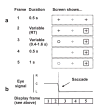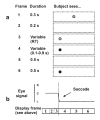Consistent chronostasis effects across saccade categories imply a subcortical efferent trigger
- PMID: 15200711
- PMCID: PMC1266050
- DOI: 10.1162/089892904970780
Consistent chronostasis effects across saccade categories imply a subcortical efferent trigger
Abstract
Saccadic chronostasis refers to the subjective temporal lengthening of the first visual stimulus perceived after an eye movement, and is most commonly experienced as the "stopped clock" illusion. Other temporal illusions arising in the context of movement (e.g., "intentional binding") appear to depend upon the volitional nature of the preceding motor act. Here we assess chronostasis across different saccade types, ranging from highly volitional (self-timed saccades, antisaccades) to highly reflexive (peripherally cued saccades, express saccades). Chronostasis was similar in magnitude across all these conditions, despite wide variations in their neural bases. The illusion must therefore be triggered by a "lowest common denominator" signal common to all the conditions tested and their respective neural circuits. Specifically, it is suggested that chronostasis is triggered by a low-level signal arising in response to efferent signals generated in the superior colliculus.
Figures



Similar articles
-
The role of action intentionality and effector in the subjective expansion of temporal duration after saccadic eye movements.Sci Rep. 2020 Oct 9;10(1):16922. doi: 10.1038/s41598-020-73830-6. Sci Rep. 2020. PMID: 33037289 Free PMC article.
-
Sound reduces saccadic chronostasis illusion.Vision Res. 2024 Feb;215:108344. doi: 10.1016/j.visres.2023.108344. Epub 2023 Dec 17. Vision Res. 2024. PMID: 38109820
-
Spatio-temporal contingency of saccade-induced chronostasis.Exp Brain Res. 2007 Jul;180(3):535-9. doi: 10.1007/s00221-007-0876-5. Epub 2007 Feb 8. Exp Brain Res. 2007. PMID: 17287990
-
The superior colliculus and eye movement control.Curr Opin Neurobiol. 1996 Dec;6(6):811-6. doi: 10.1016/s0959-4388(96)80032-8. Curr Opin Neurobiol. 1996. PMID: 9000018 Review.
-
A metanalysis of the effect of the Müller-Lyer illusion on saccadic eye movements: no general support for a dissociation of perception and oculomotor action.Vision Res. 2010 Dec;50(24):2671-82. doi: 10.1016/j.visres.2010.09.016. Epub 2010 Sep 19. Vision Res. 2010. PMID: 20858510 Review.
Cited by
-
A Second Introduction to the Neurobiology of Interval Timing.Adv Exp Med Biol. 2024;1455:3-23. doi: 10.1007/978-3-031-60183-5_1. Adv Exp Med Biol. 2024. PMID: 38918343 Review.
-
An Illusory Motion in Stationary Stimuli Alters Their Perceived Duration.Vision (Basel). 2023 Sep 18;7(3):61. doi: 10.3390/vision7030061. Vision (Basel). 2023. PMID: 37756135 Free PMC article.
-
How movements shape the perception of time.Trends Cogn Sci. 2021 Nov;25(11):950-963. doi: 10.1016/j.tics.2021.08.002. Epub 2021 Sep 13. Trends Cogn Sci. 2021. PMID: 34531138 Free PMC article. Review.
-
The role of action intentionality and effector in the subjective expansion of temporal duration after saccadic eye movements.Sci Rep. 2020 Oct 9;10(1):16922. doi: 10.1038/s41598-020-73830-6. Sci Rep. 2020. PMID: 33037289 Free PMC article.
-
The Stair Climb Power Test as an Efficacy Outcome in Randomized Trials of Function Promoting Therapies in Older Men.J Gerontol A Biol Sci Med Sci. 2020 May 22;75(6):1167-1175. doi: 10.1093/gerona/glz167. J Gerontol A Biol Sci Med Sci. 2020. PMID: 31282538 Free PMC article.
References
-
- Allan LG, Gibbon J. A new temporal illusion or the TOE once again? Perception and Psychophysics. 1994;55:227–229. - PubMed
-
- Allan LG. The influence of the scalar timing model on human timing research. Behavioural Processes. 1998;44:101–117. - PubMed
-
- Dennett DC, Kinsbourne M. Time and the observer: The where and when of consciousness in the brain. Behavioral and Brain Sciences. 1992;15:183–247.
-
- Deubel, H. (1996). Visual processing and cognitive factors in the generation of saccadic eye movements. In W.Prinz & B. Bridgeman (Eds.), Handbook of perception and action. Volume 1: Perception (pp. 143–189). London: Academic press.
-
- Duhamel JR, Colby CL, Goldberg ME. The updating of the representation of visual space in parietal cortex by intended eye movements. Science. 1992;255:90–92. - PubMed
Publication types
MeSH terms
Grants and funding
LinkOut - more resources
Full Text Sources


